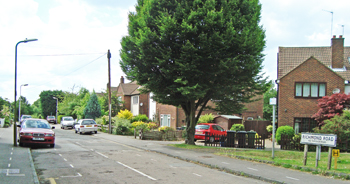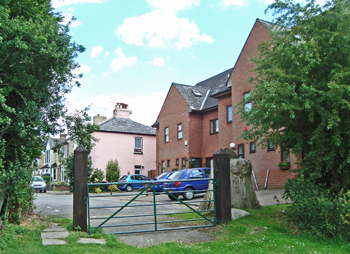Acute
The Potters Bar Cottage Hospital and dispensary opened in May 1884 in Hospital Road (later renamed Richmond Road). It had been made possible by the generosity of Mr Henry Parker, J.P., who agreed to fund the building of the Hospital and grant the use of it rent-free if sufficient funds were collected for its maintenance.
The 2-storey building was in Tudor-style, with tall chimneys. It had 10 beds and 2 cots, and cost about £2,000 to build. The ground floor contained a ward with 3 beds, a surgery, a bathroom, a kitchen and scullery, and a nurse's bedroom. On the upper floor were two wards - one with 2 beds and the other with 5 beds for convalescent patients - and two bedrooms for the staff. A separate one-storey building, also in Tudor-style, contained the wash house, the wood and coal stores, and the mortuary.
The Hospital was granted a 40-year lease. It served a local population of some 2,628 residents. Patients were treated and operated on by their own GPs, but consulting medical staff also attended from the London hospitals. As with other voluntary hospitals, fund-raising continued throughout the years, while many local people donated gifts of clothing, foodstuffs, flowers and useful items, such as bedsteads.
In 1891 the nursing staff consisted of a Matron, a nurse and a domestic servant. Occasionally, the services of a gardener or a policemen were called upon to moved a heavily-built patient from the operating theatre back to the ward, particularly upstairs.
The Hospital also treated those involved in road traffic accidents, but an unusual event occurred in March 1906, when two bullocks being led through the village from Bell Bar to Barnet Market became unmanageable as their approached the Vicarage. One rushed onto the footpath, knocking down the elderly sexton of St John's Church, who had placed himself in front of a nurse wheeling the Vicar's baby in a pram. The sexton was removed to the Hospital. The other beast made for an invalid chair containing an elderly lady. The person in the charge of the chair, a Mr Cracknell, stepped in front of the chair and challenged the animal, which veered away. Eventually the bullocks were driven to the 16th milestone, where they were recovered, exhausted.
During WW1 the Hospital continued its work, but fund-raising activities were affected, as was the income from subscriptions. By this time the average stay of an in-patient was 33 days. Additional hospital accommodation for wounded servicemen was provided by the Red Cross Society and the Voluntary Aid Detachment at Hillside in Southgate Road and at Little Heath Wood House. The three hospitals benefitted from the profits made by the town baker Mr H.W. Tilbury, who charged the public for the privilege of viewing, from his field at the top of Mutton Lane, the funeral procession for the 16 crew members of the German airship Zeppelin L-21, brought down at Cuffley on 3rd September, 1916. The airmen were interred in Potters Bar cemetery. (At a Red Cross sale at Barnet farmers market in 1917, Lady de la Rue auctioned a matchbox made from a piece of the airship. It fetched £40.)
In 1919 a second-hand X-ray apparatus was installed.
By 1923 the average cost of an in-patient per week was £1 2s (£1.10), and the average length of stay was 14 days. Some 29 major operations had been performed that year, and 88 minor ones. Of the major ones, 15 had been done by local GPs and 14 by honorary consulting surgeons from London. However, the Hospital's financial situation was dire and it was feared that its services would have to be curtailed, or patients charged in addition to the fees they already paid for treatment. The 40-year lease was also due to expire. Mr Parker's Executors were approached and a deal was made (its details are unknown) and the Hospital continued to serve its community.
In 1933 the X-ray machine had become too expensive to repair and a new one was needed, at a cost of £175. A number of the Hospital's prominent supporters soon promised various sums of money but, in the event, Mrs McNish Porter of Fairlawn, Northaw, donated the sum in memory of her late husband, Dr McNish Porter. The other promised moneys were put to alternative uses to the benefit of the Hospital.
In June 1934 the 12-bedded Hospital celebrated the Jubilee of its foundation by holding a 2-day fete. This ended with a huge bonfire and a fireworks display, having raise about £1,000 for the Hospital.
In the same year Councillor H. Shillitoe, Chairman of the Hospital, offered a piece of land in Billy Lows Lane on which to build a new hospital. The population of Potters Bar had increased from 5,720 in 1931 to an estimated 8,570 three years later. The 720 inhabited houses in 1921 had increased to 2,900 by 1934; 299 houses were built during 1934 and 1935, and the demand on hospital services had consequently risen.
A public meeting was held in July 1937 and the plans for a new hospital on Cllr Shillitoe's land unanimously approved. It was agreed that the scheme should be carried out as quickly as possible and that the project not cost more than £20,000 (half of which was already in hand). However, at a meeting of the Potters Bar Urban District Council, a committee was appointed to discuss the generous offer made by the baker Mr Tilbury, to donate a parcel of land - some 5.5 acres - opposite the cemetery in Mutton Lane for Council use. Mr Tilbury offered the remaining 6 acres of the field as a site for the proposed new hospital. The offer was accepted and, in 1938, Cllr Shillitoe sold the land in Billy Lows Lane, giving the proceeds of the sale to the new hospital project.
Work began on the new hospital building in October 1938 and was scheduled to be completed in nine months, at a cost of £26,429.
In August 1939, just before the outbreak of WW2, the Hospital moved to its new purpose-built premises in Mutton Lane. It was renamed the Potters Bar and District Hospital.
Present status (June 2009)
Today there is no trace of the Cottage Hospital. The site has been redeveloped with new housing.

Hospital Road, off Hatfield Road, had been renamed Richmond Road by the 1970s.

The site of the Hospital at the foot of Richmond Road now contains new housing.
(Author unstated) 1917 News in brief. The Red Cross 4, 140.
Ottley B, Warren B 1995 Potters Bar Hospital (1884-1948). Journal of the Potters Bar and District Historical Society 9, 1-20.
http://archiseek.com
http://viewfinder.english-heritage.org.uk (1)
http://viewfinder.english-heritage.org.uk (2)
www.british-history.ac.uk
www.pbhistory.co.uk
Return to home page